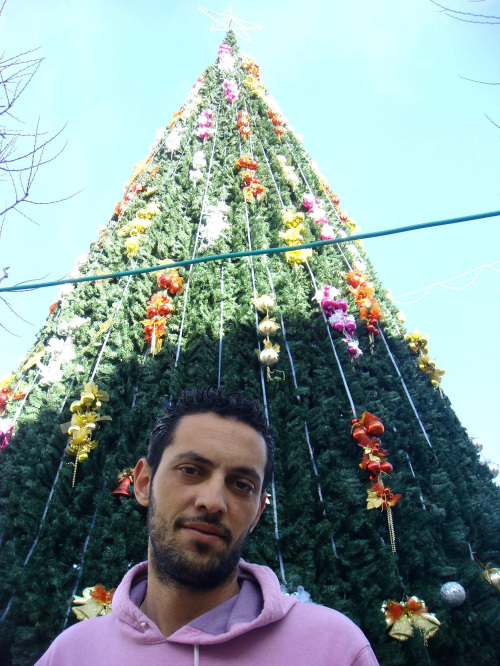 |
Nabil Giacaman, a third-generation wood carver, stands near Bethlehem’s Manger Square, where a 45-foot Christmas artificial tree was installed. (Los Angeles Times/MCT) |
BETHLEHEM, West Bank ― A 45-foot-high artificial Christmas tree towers over Manger Square, and downtown Bethlehem is festooned with sparkling decorations. There’s even a picture of a saxophone-playing Santa Claus.
But Nabil Giacaman, co-owner of a souvenir shop called Christmas House, isn’t feeling the holiday spirit.
The third-generation wood carver, who sells handmade likenesses of baby Jesus and the Virgin Mary, sees as many as 200 tour buses arrive every day from Israel to visit the Church of the Nativity, just a few steps from his store.
But the tourists are escorted directly from the bus to the church and back again. They’re rarely given time to browse the shops nearby and almost never spend the night in Bethlehem.
“My total sales the other day were $4.13,” said Giacaman, 27. “My shop is in the middle of it all, but it gets worse every year. We have tourists, but not profits.”
Parallel to the decades-old political conflict over the Holy Land, an economic battle is heating up between Israel and the West Bank-based Palestinian Authority over the market for Christian tourism.
At 1.1 million a year, the number of Christian pilgrims ― those who describe their visit as chiefly spiritual in purpose ― now surpasses Jewish tourism to Israel. Many of the top Christian sites are in the West Bank, and tourists have been returning in droves thanks to a recent lull in violence.
Many Christian pilgrims belie the image of austere travelers sleeping in religious hostels. These visitors, mostly Catholics and Christian evangelicals, spend about $200 a day on hotels, restaurants and souvenirs, compared with an average of $140 for all tourists, according to Israeli figures.
All this would seem to be only good news for Giacaman and other Palestinian businesspeople.
The reality is more complicated. Most visitors to the Holy Land arrive by air in Israel and join Israeli-led tours. So even when pilgrims visit Palestinian territory, local businesses do not necessarily profit.
Israel is moving aggressively to bring more pilgrims to the cradle of Christianity, and the Palestinians are trying to increase their share of what the visitors spend.
“We are putting a lot of emphasis on Christians,” said Oren Drori, senior deputy director of Israel’s Tourism Ministry, which recently opened a “religious affairs desk” to focus on the pilgrim niche.
The ministry has launched Christian-themed websites and a YouTube channel where visitors share their spiritual experiences. The government also provides free trips for government officials and religious leaders from Latin America, Africa and Europe to help generate interest by word of mouth.
Over the last two years, Israel has spent millions of dollars refurbishing Christian sites in Israel and trying to create new ones, such as the recently launched “Gospel Trail,” which allows hikers, bikers and motorists to retrace what may have been Jesus’ path through the Galilee region.
This year, Israel reopened access to the banks of the Jordan River, where Jesus was believed to have been baptized. The area had been largely closed as a military zone since Israel seized control of it from Jordan during the 1967 Middle East War.
For Christmas, Israel will offer free bus transportation to Bethlehem for midnight Mass, enabling pilgrims to avoid lengthy waits at Israeli checkpoints.
The Tourism Ministry is also promoting a Christmas Eve alternative to Bethlehem ― which is under the control of the Palestinian Authority ― by inviting pilgrims and foreign diplomats to the Israeli city of Nazareth to enjoy a Christmas market, parade, fireworks display and jolly Santa Claus for the kids.
Palestinians complain that they are being cut out of a market they once dominated. Palestinian tourism officials say Israel is discouraging visits to areas administered by the Palestinian Authority and is promoting attractions in other parts of the West Bank, such as the baptismal site at the Jordan River.
“We have more sites on our side, and Israel is using them to develop their own tourism, leaving us with a smaller piece of the pie,” said Palestinian Authority Tourism Minister Kholoud Daibes, contending that Israel collects 90 percent of pilgrim-related revenue. “They are promoting occupied territory as part of Israel.”
Palestinians are trying to increase their share of the market, constructing nearly 1,000 hotel rooms over the last year. A $20 million renovation of Bethlehem’s Church of the Nativity is planned.
But Palestinians say that Israel has an overwhelming advantage because of its easy access to the West Bank and its control over security. Last year, Israel began allowing Israeli tour guides to lead groups in Bethlehem. Only a few Palestinian guides are allowed to work in Israel, and legislation is pending that would require all Jerusalem guides to be Israeli citizens.
“They are trying to steal our tourists, but they can’t steal this place,” said Ziad Bandak, the Palestinian Authority’s presidential advisor on Christian affairs, motioning toward the 1,700-year-old Church of the Nativity. “You can’t be a pilgrim and not come here.”
By Edmund Sanders
(Los Angeles Times)
(Distributed by MCT Information Services)








